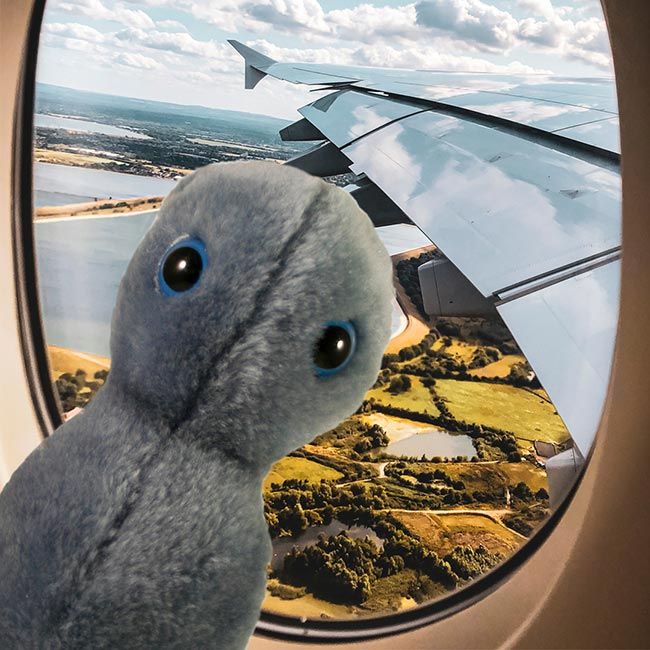Clap - Gonorrhea (Neisseria gonorrhoeae)
GIANTmicrobes STDs were featured on NPR's popular game show Wait Wait.. Don't Tell Me!
Product Details
Additional Information
| Sizes | Giantmicrobes are based on actual microbes, cells, organisms and other critters, only 1,000,000 times actual size! Gigantic (GG) 40-60cm XL (XL) 25-38cm Original (PD) 12-20cm Minis (MM) 5-10cm each Keychain (KC) 5-10cm with clip |
|---|---|
| Materials | Plush from all new materials. Stuffed with polyester fiber fill. Surface washable: sponge with water & soap, air dry. |
| Packaging | Each plush microbe includes a printed card with fun, educational and fascinating facts about the actual microbe or cell. |
| Safety | Every product meets or exceeds U.S. and European standards for safety. For ages 3 and up. |
All about Clap - Gonorrhea (Neisseria gonorrhoeae)
FACTS: The clap, or gonorrhea, is one of the most common sexually transmitted diseases. (The word "clap" comes from "clapier,” the old French word for brothel.)
According to the World Health Organization, gonorrhea causes “infections principally of the urethra in men and endocervix in women, although it may also infect extragenital mucosal sites, including the oropharynx and anorectum.” In plain English, it causes: itchiness, burning, abominable pain, and eye-catching discharges from infected areas.
While symptoms generally occur within a week or so of infection, in a large number of cases – particularly in women – no symptoms are observed. Not only does this help the disease spread, but untreated gonorrhea can cause pelvic inflammatory disease which can scar the uterus, increase the risk of ectopic pregnancy, and ultimately cause infertility. In addition, babies born to infected mothers can suffer blindness and life-threatening blood infections. Finally, gonorrhea infections can raise the risk of H.I.V. transmission by up to 500 percent.
Gonorrhea is generally contracted by young adults – and as it is spread almost entirely by sexual activity, promiscuity is the prime risk factor.
For those at risk, testing is essential: in most cases the clap can be treated with a single dose of antibiotics. But hold the applause: not only are resistant strains beginning to emerge, but if the reproductive system has been damaged, antibiotics will not repair it.
| Name | Named after the scientist who discovered it and the Greek word “gonos rhoe”, meaning “seed flow”, to describe the discharge. It earned the nickname “The clap” during the 1700’s before the disease was well understood and the popular treatment was to clap the infected penis between two wooden paddles! Ouch! |
|---|
| Actual Size | 0.6 micrometers, or 25 thousand times smaller than a jelly bean! |
|---|
| Where It Lives | Gonorrhea, also known as “The Clap”, is an infectious disease caused by a bacteria, called Neisseria gonorrhea. It’s spread from person-to-person during unprotected sex. |
|---|
| Symptoms | People with gonorrhea usually experience a painful, burning sensation while urinating. It also causes itchiness, bleeding, and produces a yellowish discharge from the genital area. |
|---|
| Cure | Antibiotic treatment with ceftriaxone sounds infinitely more pleasant than getting hit between two paddles! |
|---|
| History |
Gonorrhea was discovered in 1879 by, German scientist Albert Ludwig Sigesmund Neisser. Big Outbreaks: 1999: There was an estimated 62 million people infected with gonorrhea worldwide. That’s more than twice the population of Canada in 1999! Recent Outbreaks: 2013: Outbreak occurred in the West United States: Washington, Oregon, and California 2015: An outbreak of drug-resistant gonorrhea detected in England. Drug-resistant bugs are not affected by the usual antibiotic treatment so they’re more difficult to treat. |
|---|
| Fascinating Facts |
Half of women infected by gonorrhea don’t show signs or symptoms, but it doesn’t mean they’re not affected by it. Before antibiotics, gonorrhea was a leading cause of infertility! Famous people who died of it: Fortunately, people don’t usually die of gonorrhea, but they can get it more than once. The infamous 18th century Italian writer and heartthrob, Giacomo Casanova, had it four times! Love wasn’t the only thing he was spreading over Rome! |
|---|










